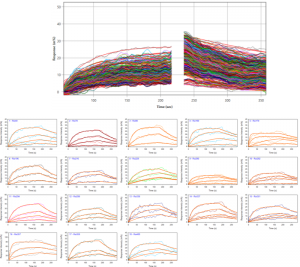Membrane proteins play critical roles in cellular communications and are the most popular drug targets, accounting for over a half of the FDA approved drugs. One particularly important example of membrane proteins is G protein coupled receptors (GPCRs), which constitute the largest and most diverse protein family in the human genome with over 800 members identified to date.[1] GPCRs are responsible for numerous cellular and physiological processes, including cell proliferation, differentiation, neurotransmission, development and apoptosis, and cancer growth and development. [2] Unsurprisingly, GPCRs are the largest family of membrane protein drug targets. A key task in studying the physiological functions of GPCRs and developing drugs targeting GPCRs is to measure the binding kinetics of ligands with GPCRs.
GPR39 receptor was studied against 3,4-bis-(2-imidazol-1-ylethoxy)-benzonitrile (AZ1395) [3] using SPRm 200. The GPR39 receptor is expressed in metabolic tissues including pancreatic β-cells and has been proposed as a type 2 diabetes target.
SPRm 200 is the world’s first commercial Surface Plasmon Resonance Microscope. It combines high spatial resolution of optical microscopy with the sensing capability of SPR, making it possible to measure the binding of molecules with membrane proteins on single intact cells without labels. HEK 293 cells were incubated on a SPR sensor surface, AZ1395 (~300 Da) was introduced with a flow system and binding of the molecule with GPR39 was determined from the sensorgrams of different regions (~450 Regions of Interest (ROIs) with each measuring ~20 um x ~30 um). This unique capability enables statistical analysis of binding affinity and kinetic constants of individual cells, allowing measurement on single intact cells and study of cell heterogeneity (Fig. 1). The average KDwas found to be 413 nM with standard deviation of 42 nM (Fig. 2). This value is in good alignment with previously reported publication measured with orthogonal techniques.[3] The kinetics constants (Figs. 3 and 4) obtained were ka= 6.92 x 103M-1s-1 (0.721×103 stdev) and kd= 4.27 x10-3s-1 (0.720 x 10-3 stdev).
In conclusion, SPRm 200 offers high spatial resolution SPR with simultaneous optical microscopy capability. This makes it possible to measure molecular binding on membrane proteins of individual cells without the need of extracting the proteins and perform statistical analysis of protein expression level, affinity and kinetics from a large number of different cells.
We thank Dr Maria Flocco, Dr Philip Rawlins and Dr Niklas Larsson from AstraZeneca for the samples and valuable discussions.
Author: Nguyen Ly | Biosensing Instrument | Published Jan 4, 2025
DOWNLOAD PDF
Download a PDF of Application Note 129: AZ1395 small molecule targeting GPR39
- Tang, Xiao-long et al, Acta Pharmacol Sin. 2012 Mar; 33(3): 363–371.
- Locatelli-Hoops E et al, Biomed Spectrosc Imaging, 2013, 2(3), 155-181.
- Fjellström O et al, PLoS ONE, 2015, 10(12): e0145849.





